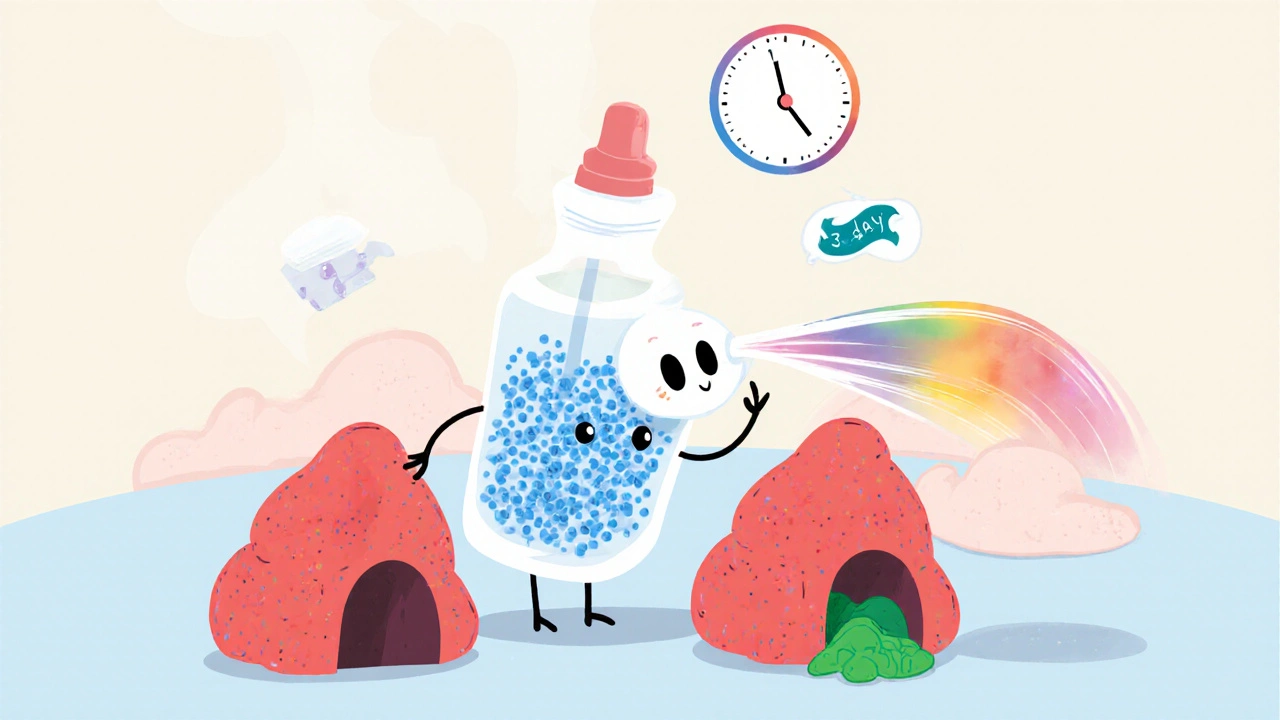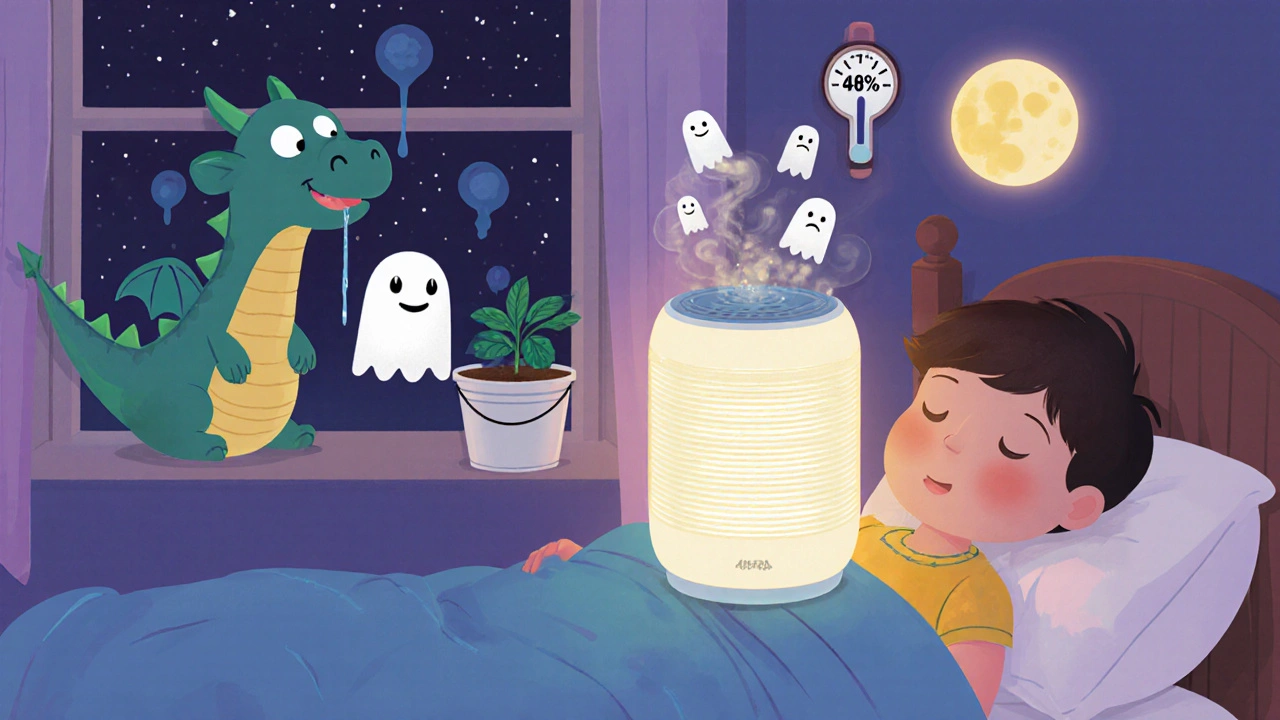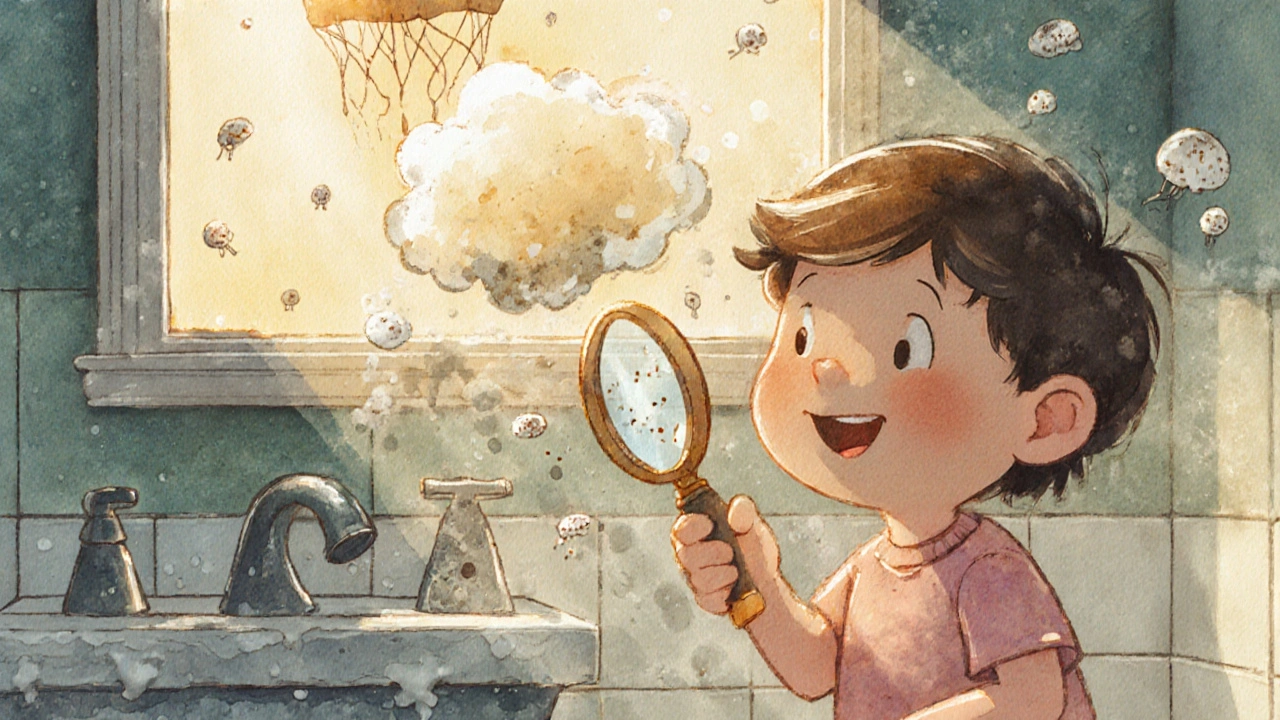If you live in a humid climate like Phoenix and notice your allergies get worse every fall, mold could be the hidden culprit. Unlike pollen that comes and goes with the seasons, mold grows year-round in damp places-bathrooms, basements, even inside air conditioners. And when you breathe it in, your immune system goes into overdrive. That’s where fluticasone comes in. It’s not a cure, but for millions of people, it’s the difference between constant sneezing and actually breathing easy.
What is fluticasone?
Fluticasone is a corticosteroid, a type of medicine that reduces inflammation. It’s not an antihistamine like Claritin or Zyrtec. Instead of blocking histamine, it targets the root cause: swelling in your nasal passages. When mold spores trigger your allergies, your nasal lining swells up, gets red, and produces excess mucus. Fluticasone calms that down. You get it as a nasal spray-usually one or two sprays in each nostril once a day.
It’s sold under brand names like Flonase and Veramyst, but generic fluticasone propionate works just as well and costs a lot less. A 30-day supply of the generic version can run under $15 at most pharmacies. It’s available over the counter in the U.S. since 2014, which means you don’t need a prescription anymore. But that doesn’t mean it’s harmless. You still need to use it right.
Why fluticasone works better than antihistamines for mold
Mold allergies aren’t like a cold. They’re chronic. Mold spores are everywhere indoors and out, especially in the Southwest where monsoon season leaves moisture behind. Antihistamines help with sneezing and runny nose, but they do little to stop the swelling that makes your nose feel stuffed up. That’s why people often say, "I took Claritin and still couldn’t breathe."
Fluticasone tackles the inflammation directly. A 2023 study in the Journal of Allergy and Clinical Immunology showed that patients using fluticasone had a 65% greater reduction in nasal congestion compared to those using oral antihistamines alone. It also reduces postnasal drip, itchy eyes, and even sinus pressure over time.
Think of it this way: antihistamines are like turning off a fire alarm. Fluticasone is like putting out the fire. For mold allergies, you need to put out the fire.
How to use fluticasone correctly
Most people don’t get the full benefit because they use it wrong. Here’s how to do it right:
- Blow your nose gently before spraying to clear out mucus.
- Shake the bottle well.
- Tilt your head slightly forward-not back. Looking up can make the spray drip down your throat.
- Close one nostril with your finger. Insert the nozzle just inside the other nostril, aiming toward the outer wall (not straight up or toward the center).
- Press the pump while breathing in slowly through your nose. Don’t sniff hard-that sends the medicine to your throat.
- Repeat for the other nostril.
- Don’t blow your nose right after. Wait at least 15 minutes.
It takes 3 to 7 days to start working. Some people give up too soon. Don’t. It’s not meant to be fast-acting like an epinephrine shot. It’s a daily maintenance tool. Use it every day, even if you feel fine. Mold spores are always there. Skipping doses lets inflammation creep back.
Side effects you should know about
Fluticasone is safe for long-term use, but it’s not side-effect-free. The most common issue is nosebleeds. About 1 in 10 users gets a mild bleed, especially if they spray too hard or use it too often. Dryness and irritation are also common. These aren’t dangerous, but they’re annoying.
Less common but serious: fungal infections in the nose or throat (oral thrush). That’s why you should rinse your mouth with water after each use-even though the spray doesn’t go into your stomach, a tiny bit can land in your throat. Swishing and spitting helps prevent yeast overgrowth.
Very rarely, long-term high-dose use can affect adrenal glands or cause cataracts. But that’s only with doses far higher than the standard 1-2 sprays a day. Stick to the label. Don’t double up if you miss a dose. Just take the next one as scheduled.

Who should avoid fluticasone
You should talk to your doctor before using fluticasone if:
- You’ve had recent nasal surgery or injury
- You have untreated nasal infections (like a bacterial or fungal sinus infection)
- You have glaucoma or cataracts
- You’re pregnant or breastfeeding-while studies show it’s low risk, your doctor should weigh the benefits
- You’re taking other steroid medications (like prednisone) and you’re unsure about total dose
If you’re on HIV meds like ritonavir or ketoconazole, they can interfere with how your body breaks down fluticasone. That could raise your risk of side effects. Always list all your meds when you ask for this spray.
What else helps with mold allergies?
Fluticasone is powerful, but it’s not a magic bullet. Mold allergies get worse when you’re exposed to more spores. Reducing exposure is just as important.
- Use a HEPA air purifier in your bedroom. It cuts airborne mold spores by 80% or more.
- Fix leaks. Even small drips under sinks or behind toilets create perfect mold habitats.
- Keep indoor humidity below 50%. A $20 hygrometer from Amazon tells you if you’re over.
- Clean bathrooms weekly with a bleach solution or hydrogen peroxide. Vinegar works too, but it’s less effective on stubborn black mold.
- Don’t leave wet towels or clothes lying around. Mold loves damp fabric.
- Change your HVAC filters every 30-60 days. Cheap filters don’t catch mold spores.
Some people try saline rinses (Neti pots). They help flush out spores and mucus, but they don’t reduce inflammation. Use them alongside fluticasone-not instead of it.
How long should you use fluticasone?
There’s no set end date. If mold is a year-round problem in your home, you may need to use it seasonally-or all year. Many patients use it from August through November, when mold counts peak. Others use it daily because they live in a humid apartment or have chronic sinus issues.
Doctors often recommend trying it for 4-6 weeks to see if it helps. If your symptoms improve, keep using it. If not, it might not be mold. You could have dust mites, pet dander, or even non-allergic rhinitis. A simple skin prick test at an allergist’s office can confirm what you’re reacting to.
Don’t stop fluticasone suddenly if you’ve been using it for months. Your body gets used to it. Tapering off slowly (like using it every other day for a week) helps prevent rebound congestion.

Alternatives to fluticasone
If fluticasone doesn’t work-or gives you too many side effects-there are other options:
| Medication | Active Ingredient | Dosing | Onset | Common Side Effects |
|---|---|---|---|---|
| Fluticasone | Fluticasone propionate | 1-2 sprays per nostril daily | 3-7 days | Nosebleeds, dryness |
| Mometasone | Mometasone furoate | 1 spray per nostril daily | 2-4 days | Headache, sore throat |
| Budesonide | Budesonide | 1-2 sprays per nostril daily | 1-2 days | Nasal irritation, bitter taste |
| Triamcinolone | Triamcinolone acetonide | 1-2 sprays per nostril daily | 3-7 days | Nosebleeds, nasal ulcers |
Mometasone (Nasonex) and budesonide (Rhinocort) are close alternatives. Budesonide works faster and is often recommended for kids. Triamcinolone (Nasacort) is also OTC and works well, but it’s slightly more likely to cause nosebleeds. If one doesn’t work, another might.
For severe cases, allergy shots (immunotherapy) are the only long-term solution that changes how your body responds to mold. It takes 3-5 years, but many patients eventually stop needing sprays altogether.
When to see a doctor
You don’t need to see a doctor to buy fluticasone. But you should if:
- Your symptoms don’t improve after 4 weeks of daily use
- You have frequent nosebleeds, facial pain, or thick yellow/green mucus (signs of infection)
- You’re using it for more than 6 months without a break
- You have asthma and your breathing worsens
- You’re pregnant or planning to become pregnant
An allergist can test you for specific mold types (like Aspergillus or Cladosporium) and help you build a full plan-medication, environmental control, and possibly immunotherapy.
Can fluticasone cause weight gain?
No, not at the typical nasal spray dose. Weight gain is a risk with oral steroids like prednisone, which flood your whole body with hormones. Fluticasone nasal spray delivers a tiny amount directly to your nose. Less than 1% enters your bloodstream. That’s not enough to affect metabolism or cause weight gain.
Is fluticasone safe for children?
Yes, for kids 4 and older. Budesonide (Rhinocort) is often preferred for younger children because it’s approved for ages 2 and up. Always use the lowest effective dose. For kids, one spray per nostril daily is usually enough. Monitor for nosebleeds or slowed growth-though studies show no long-term impact when used correctly.
Does fluticasone help with sinus infections?
Not directly. Fluticasone reduces swelling, which can help drain sinuses better. But it doesn’t kill bacteria or fungi. If you have a true sinus infection-with fever, thick green mucus, or facial pressure lasting more than 10 days-you need antibiotics or antifungals. Fluticasone can be used alongside them to reduce congestion, but it’s not a treatment on its own.
Can I use fluticasone with antihistamines?
Absolutely. In fact, combining them is often more effective. Use fluticasone daily for inflammation and congestion, and take an antihistamine like cetirizine or loratadine for sneezing and itchy eyes. Many patients find this combo gives them the best relief from mold allergies.
How do I know if mold is really my problem?
Track your symptoms. Do they get worse after doing laundry, showering, or being in a basement? Do they improve when you leave home? If so, mold is likely. An allergist can confirm it with a skin test. They’ll prick your skin with extracts from common mold types and watch for a reaction. Blood tests (IgE) are also an option if skin testing isn’t possible.
Final thoughts
Mold allergies aren’t just annoying-they can make you feel tired, foggy, and sick for months. Fluticasone doesn’t fix your environment, but it gives your body a fighting chance. Used right, it’s one of the most effective tools we have. Pair it with real mold control at home, and you can reclaim your breathing-and your quality of life.


Fluticasone is one of the most underappreciated tools in allergic rhinitis management, particularly for mold exposure. Unlike antihistamines, which only mask symptoms by blocking histamine receptors, fluticasone modulates the entire inflammatory cascade-suppressing IL-4, IL-5, and TNF-alpha production in nasal mucosa. This is why it outperforms oral antihistamines in congestion control, as cited in the 2023 JACI meta-analysis. The key is consistency: patients often discontinue use after 3 days because they don’t feel immediate relief, but the glucocorticoid receptor binding requires 48–72 hours to initiate transcriptional repression of pro-inflammatory genes. Proper technique matters too-aiming the spray laterally toward the nasal turbinates, not the septum, minimizes epistaxis risk and maximizes mucosal contact. Generic fluticasone propionate is bioequivalent to Flonase and costs less than $0.50 per dose at Costco or Walmart. For mold sufferers in humid climates, this isn’t optional-it’s foundational.
Let’s be real-most people are using this spray like it’s a magic wand. You’re not ‘treating mold allergies,’ you’re suppressing inflammation while your environment remains a fungal petri dish. If you’re not using a HEPA filter, dehumidifier, and cleaning your AC coils monthly, you’re wasting your money. And don’t even get me started on people who think rinsing their mouth after use is optional. Oral thrush isn’t a ‘rare’ side effect-it’s predictable negligence. This isn’t medicine, it’s band-aid biology. Fix the environment or stop pretending you’re in control.
I love how this post breaks everything down so clearly! I’ve been using fluticasone for two years now because of my basement apartment in Seattle, and honestly? Life-changing. I used to wake up with my nose completely blocked every morning-now I can actually smell coffee again 😊. One thing I wish more people knew: it’s totally fine to use it year-round if you’re in a damp place. I used to think I had to ‘take breaks’ like with antibiotics, but my allergist said nope-mold doesn’t take vacations. Also, the saline rinse trick? Game changer when I do it before spraying. Just don’t use tap water-distilled or boiled is best. You’re not just treating symptoms, you’re reclaiming your breathing. So proud of myself for sticking with it!
bro i tried fluticasone and it made my nose bleed so bad i thought i was gonna die 😭 like wtf is this witchcraft?? i sprayed it once and then my whole face felt like it was on fire and then blood just… came out?? i thought it was supposed to help?? now i just snort benadryl and pray. also my cat sneezes more than i do so i think the mold is in the walls or something?? 🤡 #moldlife #fluticasoneisnotmyfriend
Have you considered that fluticasone is not just a treatment, but a tool of pharmaceutical control? Corticosteroids suppress immune response-not cure it. The FDA approved it OTC in 2014 precisely because they wanted to shift responsibility from environmental remediation to individual pharmacological compliance. Mold exposure is a public health crisis tied to poor housing policy, yet we’re told to spray our noses instead of demand mold-free apartments. The ‘side effects’ they list? Minor. The real danger is normalization: you’re being trained to accept chronic illness as inevitable. Who profits? Big Pharma. Who suffers? Everyone living in aging infrastructure. This isn’t medicine. It’s systemic surrender.
OMG I just realized I’ve been using this spray WRONG this whole time 😭 I was aiming it straight up like I was trying to water a plant inside my nose 🤦♀️ and now I get why I kept getting nosebleeds. I just switched to the lateral technique and I’m already breathing better. Also, I started rinsing my mouth after and now I don’t have that weird fungal taste anymore. Thank you for this post. I feel like I’ve been given a superpower. 🙌✨
Interesting how we treat fluticasone like a magic bullet when it’s really just a temporary equilibrium. The body adapts, the mold doesn’t disappear, and we keep spraying. I wonder if the real question isn’t ‘how to use it better’ but ‘why are we living in environments that demand this daily chemical intervention?’ There’s dignity in self-management, yes-but there’s injustice in being forced to medicate just to breathe in your own home. I’ve seen people in rent-controlled apartments with visible mold on the walls being told to ‘just use Flonase.’ That’s not healthcare. That’s survival.
There’s a quiet tragedy in how we’ve reduced environmental health to pharmaceutical compliance. Mold is a natural organism, and our bodies evolved alongside it. But modern construction-sealed homes, synthetic insulation, HVAC systems that don’t ventilate-has turned a minor ecological factor into a chronic medical condition. Fluticasone helps. But it doesn’t heal. It’s a pause button, not a reset. Perhaps the real medicine isn’t in the spray bottle, but in the willingness to rebuild homes that breathe, to prioritize air quality over cost efficiency, and to see health not as individual responsibility, but as collective design. We treat symptoms because systems fail us. That’s not just medical-it’s moral.
I just wanted to say thank you for writing this. My mom had chronic sinus issues for 15 years and thought it was just ‘aging.’ She started fluticasone after reading something like this, and within three weeks, she was sleeping through the night for the first time in over a decade. She cried when she told me she could smell her roses again. It’s easy to dismiss nasal sprays as ‘just a Band-Aid,’ but for some of us, it’s the difference between living and just existing. I’m grateful for people who take the time to explain this stuff clearly. You helped my family.
YES to the HEPA filter tip!! I got a $30 one from Target and it’s been a game-changer-my husband even noticed the dust is gone from the bookshelves 😅 Also, if you’re using vinegar for mold, add a splash of tea tree oil-it’s antifungal and smells way better. And for the love of all things holy, don’t skip the 15-minute wait after spraying! I used to blow my nose right away because I was impatient… and then I wondered why nothing worked. Patience is the real active ingredient. You got this. You’re not alone. Keep going. 💪🌿